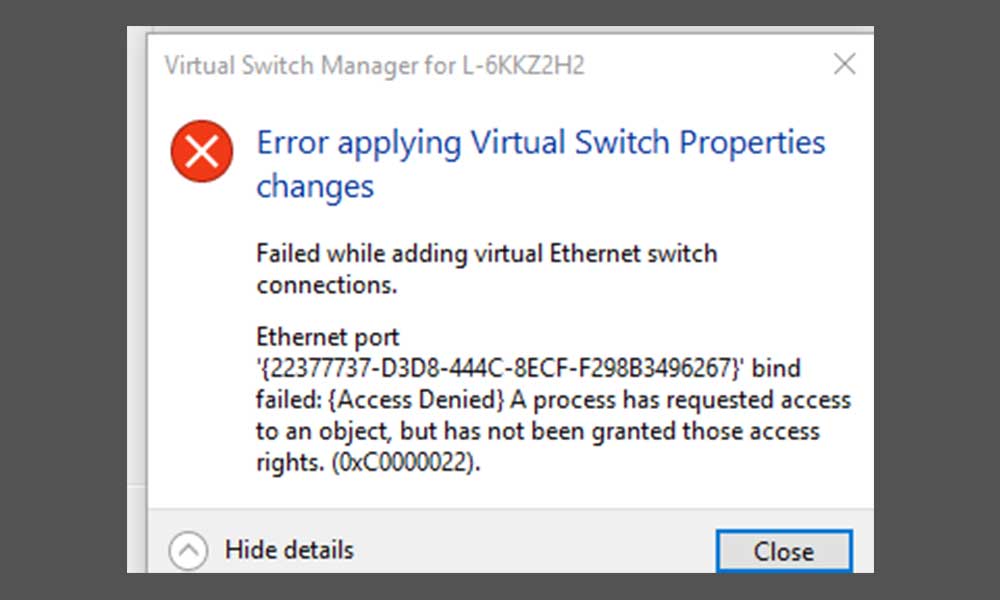The Windows 10 users are literally getting issues with the network adapter and host for the Hyper-V virtual switch network. Some users are experiencing error applying virtual switch properties changes with Hyper-V. So, Windows 10 users aren’t able to create an external switch in Hyper-V client. The error message says “Failed while adding virtual Ethernet switch connections.” along with a bunch of error codes. If you’re also one of the victims then check this troubleshooting guide.
According to some of the affected users, whenever they trying to create a virtual switch over the external network on the ethernet port, they get an error message that the “ethernet port bind failed (access denied). A process has requested access to an object but has not been granted those access rights. (0xC0000022).” Now, the interesting part is that users can still create an internal or private virtual network but not the external for PXE boot.
Also Read

Page Contents
Fix: Error applying Virtual Switch Properties changes – Hyper-V
Here we’ve provided some of the possible workarounds below that you should try on your PC.
1. Use PowerShell Method
- Click on the Start menu on your Windows > Type PowerShell > Right-click on it from the search result > Select Run as administrator mode.
- Type the following command and hit Enter in order to create a new external virtual switch.
New-VMSwitch -name ExternalSwitch -NetAdapterName Ethernet -AllowManagementOS $true
Note: Replace name with the network adapter for Hyper-V Manager. NetAdapterName will replace the name of the command. AllowManagementOS is $true for both the host and VM that have an internet connection.
- Now, open Virtual Switch Manager in Hyper-V Manager.
- You can check whether an external switch is visible in the list or not. If not, then follow the next method.
2. Use ‘netcfg’ Command to Reset Network Connection
Netcfg is a utility command in order to manage network configurations. Now, execute this command via the Windows PowerShell. This one command will remove all your existing connections. Make sure to create a system restore point before executing this command for safety purposes.
- Click on the Start menu > Type PowerShell and right-click on it from the search result.
- Select Run as administrator.
- Type the following command and press Enter in order to restart all network adapters & remove MUX objects.
netcfg -d
- Launch the Virtual Switch Manager in the Hyper-V Manager.
- Next, you can create an external switch and check whether the issue has been fixed or not.
3. Re-install Network Adapter
- Click on Start > Type Device Manager > Click on it from the search result.
- Expand Network Adapters > Click to select the network adapter you want to re-install.
- Right-click on the network adapter > Choose Uninstall device.
- Select ‘Delete the driver software for this device’ > Click on Uninstall.
- Restart your Windows PC and then launch Virtual Switch Manager in Hyper-V Manager & try to create an external switch.
4. Update Network Adapter Driver
- Click on Start > Type Device Manager > Click on it from the search result.
- Expand Network Adapters > Select the network adapter you want to update.
- Just right-click on the network adapter > Choose Update Driver.
- Reboot your PC and check for the issue again.
5. Adjust Network Sharing
- Open Virtual Switch Manager in Hyper-V Manager.
- Next, you can create an Internal Switch.
- Press the Windows logo + R key to open up the Run dialog box.
- Now, type the below command and press Enter.
inetcpl.cpl
- Next, right-click on your network adapter whether you’re using a wired/wireless connection.
- Click on Properties > Sharing tab > Choose ‘Allow other network users to connect through this computer’s Internet connection’.
- Select the adapter from the list > OK.
- Right-click on your virtual machine > Click on Settings.
- Now, click on Network Adapter > Select the new Internal switch.
- Access the guest operating system. You can also adjust the network settings if you want.
That’s it, guys. We hope you’ve found this article useful. For more queries, you can comment below.
